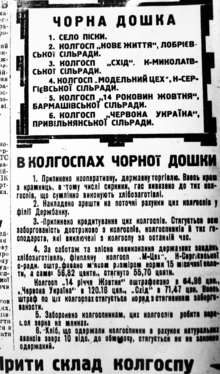Blackboards (Soviet policies)
Black boards — synonymous with "boards of infamy", were an element of agitation-propaganda in the Soviet Union, and especially Ukraine in the 1930s, coinciding with the Holodomor, the artificial famine imposed by the Soviet regime as part of a policy of repression.

| Part of a series on the |
| Holodomor |
|---|
| Historical background |
|
| Soviet government |
|
Institutions
Policies
|
| Responsible parties |
| Investigation and comprehension |
The policy was part of the collectivization process and the fight with kulaks (kurkuls). The "black boards" were installed at entrances to a settlement and identified the residents that were accused of counter-revolutionary activity and who were the enemies of the people, allegedly trying to undermine the process of collectivization. The fact of nominating of such settlements was published in the oblast newspapers listing the names of collective farms that resisted collectivization and the Soviet regime.
However some of the archives reflect that "black boards" were used precisely as a repressive element in the fight not only against the collectivization resistance, but also against the nationality factor of the local population. For example, in 1932 the Vinnytsia Oblast Communist Party Committee suggested the local village of Mazurivka to be nominated to "black boards", because there was born one of the Petlyura's generals Khmara, while the village of Karpivtsi (Chudniv Raion) in Volyn was known as one of the Petlyura's. The village of Turbiv (Lypovets Raion), for example, deserved such a penalty for its "high infestation of the Petlyura element and participation in the Plyskiv affair in spring". Each settlement or an administrative unit with black boards was encircled by armed squads and was subjected to complete food requisitioning.
In the end at least 400 collective farms where put on the "Blackboard," more than half of them in Dnepropetrovsk Oblast alone.[1] This oblast is situated right in the middle of traditional lands of the Zaporizhian Cossacks.
References
- Постанова Політбюро ЦК КП(б)У про заходи з посилення хлібозаготівель від 18.11.1932 р. : Голодомор 1932-1933 років в Україні: Документи і матеріали / Упор. Р. Пиріг. - К.: ВД "Києво-Могилянська академія", 2007. (in Ukrainian)
- Центральний державний архів вищих органів влади і управління України, ф. 806, оп. 1, спр. 22, арк. 532. (in Ukrainian)
- Командири великого голоду: Поїздка В. Молотова та Л. Кагановича в Україну та на Північний Кавказ. 1932-1933 рр. / За ред. В. Васильєва та Ю. Шаповала. - К.: "Генеза", 2001. (in Ukrainian)
- Постанова ЦК КП(б)У та РНК УСРР про зняття з "чорної дошки" с. Кам'яні Потоки Кременчуцького району Харківської області, 17.10.1933. - Голодомор 1932-1933 років в Україні: Документи і матеріали / Упор. Р. Пиріг. - К.: ВД "Києво-Могилянська академія", 2007. (in Ukrainian)
- Голодомор 1932-1933 років на Сумщині / Упор.: Покидченко Л. А. - Суми: Видавництво "Ярославна", 2006. (in Ukrainian)
- Спокута: Голодомори на Запоріжжі (1921-1922, 1932-1933, 1946-1947 рр.) / Статті, документи, спогади. - Запоріжжя: "Дніпровський металург", 2008. (in Ukrainian)
External links
- Black boards of Holodomor (in Ukrainian)
- Serhiy Bilokin. Armed man the first and main enemy of Bolshevism (in Ukrainian)
- Ukrainian Institute of the National Memory (in Ukrainian)